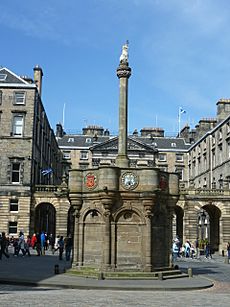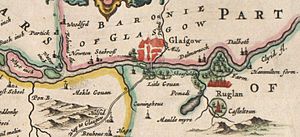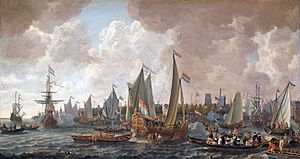Scotland under the Commonwealth facts for kids

This is the story of Scotland during a special time, from February 1652 to June 1660. During this period, Scotland was part of the Commonwealth of England. This meant it was no longer an independent kingdom. It became part of England until the king returned in 1660.
After King Charles I was executed in 1649, the Scottish Parliament chose his son, Charles II, as their new king. He was declared King of Scotland, England, and Ireland. England, now a Commonwealth, didn't like this. So, Oliver Cromwell led an army into Scotland. The Scottish army lost battles at Dunbar and Worcester. These defeats allowed England to take control of Scotland.
In 1652, Scotland officially joined England and Ireland as part of the Commonwealth. This was called the "Tender of Union." It took a few years for this union to become a law in England. Scotland gained 30 members in the English Parliament. However, many of these spots were empty, or filled by English officials. This meant Scots had little say in the government.
At first, eight English leaders ran Scotland. They tried to reduce the power of the Scottish nobles. Later, in 1655, a new Council of Scotland took over. It tried to get the support of the traditional Scottish landowners. The new government also built many forts and citadels (strong castles) across Scotland. This cost a lot of money.
The Scottish legal system was paused for a while. But some courts slowly started working again. Overall, the new government was good at keeping law and order. It stopped groups of bandits, called moss-troopers. There was a big uprising in the Highlands from 1653 to 1655. It was led by William Cunningham, 9th Earl of Glencairn and John Middleton, 1st Earl of Middleton. This uprising had some early success. But it faced problems from within and ended after a defeat at the Battle of Dalnaspidal in 1654.
The Commonwealth allowed different types of Protestants to practice their faith. But it did not allow Catholics or Episcopalians (those who supported bishops). The main church in Scotland, the Kirk, was divided. This happened because some members wanted to work with the king (Resolutioners). Others, called Protesters, wanted to keep the church pure. The government usually supported the Protesters.
Scotland had to pay high taxes during this time. But it also gained access to English markets. Some people remembered this time as a period of growth and wealth. However, not all parts of Scotland benefited equally. After Oliver Cromwell died, his son Richard's government fell apart. General Monck, who was in charge of the army in Scotland, marched south. He helped bring King Charles II back to power in 1660. This meant Scotland became an independent kingdom again.
Contents
How Scotland Joined the Commonwealth
After the English army won the battle at Worcester, England decided what to do with Scotland. At first, they thought about just taking over Scotland. But then they decided it would be better if Scotland joined England as one country. This idea was called the "Tender of Union."
On February 4, 1652, this union was announced in Edinburgh. The King's symbols were taken down from the Mercat Cross. Many Scottish areas and towns agreed to join the Commonwealth. They promised that Scotland would become "one Commonwealth with England."
A law to make this union official was started in the English Parliament. But it took a long time to pass. Finally, in 1654, an official order was made. It said Scotland was united with England and Ireland. This union became a full law in 1657.
Under this union, Scotland got 30 seats in the English Parliament. But often, not all these seats were filled. Many of the Scottish members were not listened to. One Englishman even said they were like "a wooden leg tied to a natural body." This shows how little influence they had.
Running Scotland
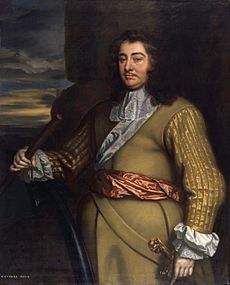
When Scotland joined the Commonwealth, its own Parliament and monarchy were removed. No Scottish group could meet without permission from the English Parliament. At first, eight English leaders ran Scotland. They wanted to reduce the power of the Scottish nobles. Many nobles were in jail or had lost their land. Instead, the government tried to help ordinary people and small landowners.
In 1655, a new group called the Council in Scotland took over. It was led by an Irish noble, Lord Broghill. This council tried to get the support of the important landowners. It had six English members and two Scottish members.
To keep control, people needed special passes to travel. Owning guns was also restricted. In the Highlands, clan chiefs were made responsible for their people's actions. The government always had at least 10,000 soldiers in Scotland. They built large forts in places like Ayr, Perth, and Leith. They also built 20 smaller forts, even in far-off places like Orkney. These forts cost a lot of money and needed many workers. For example, the fort at Inverness cost £50,000 by 1655, and it wasn't even finished.
The Scottish legal system was mostly stopped. Courts that got their power from the king were closed. However, local church courts, called Kirk sessions, continued to meet. English and Scottish officials took over the main legal jobs. These new judges were often fairer because they were not connected to powerful Scottish families. Local courts were officially ended in 1657. But new local courts were set up in 1656. The government was good at keeping order. People said it was safe to travel across Scotland with money, which was not true before.
Fighting Back: Glencairn's Rising
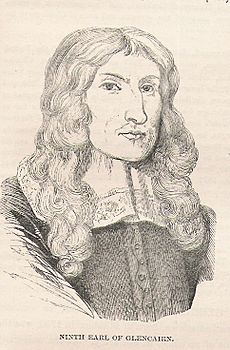
From 1653 to 1655, there was a big uprising in the Scottish Highlands. It was led by William Cunningham, 9th Earl of Glencairn and John Middleton, 1st Earl of Middleton. This uprising was a serious threat to the government. It happened at the same time as a war with the Dutch.
Glencairn was put in charge of the Scottish Royalist forces by King Charles II. He gathered Scottish leaders in August 1653. They formed a small army of Highlanders and Lowlanders. This army won a battle at Aberfoyle. This victory made more people join the uprising. It also made the Commonwealth government try to be nicer to Scottish nobles.
However, the uprising soon faced problems from within. There were arguments between the Highlanders and the Lowland leaders. In 1654, Middleton arrived with orders from King Charles II to take command. Glencairn gave up his command, even though his followers didn't want him to. Later, Glencairn was arrested after an argument. Other arguments and fights among the leaders weakened the uprising.
Middleton tried to use raids and attacks. This bothered the Commonwealth forces, but it also made the uprising unpopular. People stopped joining. George Monck, the military governor, began a strong campaign against the rebels. On July 19, 1654, Monck's forces defeated Middleton's army at Dalnaspidal. Middleton was wounded and had to escape. The war with the Dutch also ended, so the government could send more soldiers. The uprising slowly died out. Glencairn surrendered, and Middleton escaped to Europe.
This uprising made the government change its plans. Instead of trying to remove the old landowners, they tried to make peace with them. This led to the "Act of Grace and Pardon" in 1654. This act named 24 nobles whose lands would be taken. It also named 73 other landowners who had to pay a fine. But most of these people were treated kindly. Their fines were often reduced or even removed.
Religion in Scotland
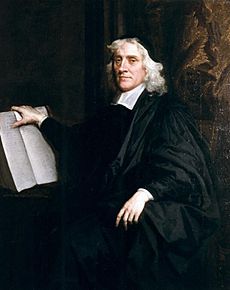
The Kirk had been mostly united since 1638. But after the defeat at Dunbar, it split into two main groups. These groups were called the Resolutioners and the Protesters. The Resolutioners were willing to work with the king. The Protesters wanted to keep the church pure and separate from royal power. These two groups became very divided.
The union promised freedom of religion for Protestants. The government accepted Presbyterianism, which was the main form of the Kirk. But it did not say it was the only true church. So, church courts continued to work as before. The government usually favored the Protesters. This was because the Resolutioners wanted the king back. Also, the General Assembly of the Church, where Resolutioners were strong, claimed to be independent from the state. In 1653, the Resolutioner members of the Assembly were forced out of Edinburgh by soldiers. There were no more General Assemblies during the Commonwealth period.
The government did not allow Episcopalians (who supported bishops) or Catholics. But if they kept quiet, they were often left alone. Other Protestant groups were allowed. A small number of Quakers came to Scotland during this time. Many people looked back at this period as a good time for Protestantism. Ministers spent more time teaching their church members. They focused on preaching, like the new Protestant groups. One church leader said that "more souls were converted to Christ in that short period of time than in any season since the Reformation."
Money and Taxes
Under the Commonwealth, Scotland paid a lot in taxes. But it also gained access to English markets. Before, Scotland paid about £17,000 a year in taxes. In 1656, the government's running costs alone were £25,000. The Cromwellian government asked Scotland for £10,000 a month in taxes. Scotland could not pay all of this, so it was reduced to £6,000 a year. The total taxes were never less than £90,000 a year. Scotland also paid about £35,000 a year in excise taxes (taxes on goods). Even with all these taxes, Scotland still had a yearly debt of £130,000. This was covered by money from England.
Scotland's economy had been badly hurt by the civil wars. Many people had died or left. Soldiers often took food and goods without paying. Many merchants lost money. The east-coast towns lost about one-fifth of their people to the plague in 1645. It took a long time for things to get better. In 1651, rents in Edinburgh had to be cut by a third.
The free trade with England was not always good for Scotland. Scotland's ships had to compete with England's more developed merchant fleet. However, the economy started to improve after 1650. Some cities like Glasgow and Aberdeen did well. But Dundee and the Fife ports continued to struggle. The money spent on building forts and paying soldiers helped some businesses. New industries like glass production started. Cromwell's soldiers are also said to have brought sock knitting and kale planting to Scotland. The peace and order brought by the army helped trade and manufacturing. One Scottish leader later said that the eight years of English rule were "a time of great peace and prosperity."
Symbols of the Union
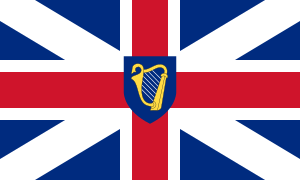
The union of Scotland and England brought back the union flag. This flag had been created by King James VI and I. It had not been used much after his death in 1625. From 1654, the flag showed England in the first and fourth sections, Scotland in the second, and an Irish harp in the third. Later, in 1658, they went back to an older version of the flag. This version combined the crosses of St. George (England) and St. Andrew (Scotland). The Irish harp was placed in the middle.
Old coins were also brought back. The "unite" coin, first made under James VI, was used again. It had the English words "The Commonwealth of England" and showed only the Cross of St. George and an Irish harp. Other coins were also made. They showed the Lord Protector on one side. On the other side, they had the crosses of St. George and St. Andrew, and the Irish harp. Even with these new symbols, some historians say the Commonwealth did not create strong symbols that made people feel united.
The End of the Commonwealth
Oliver Cromwell died in 1658. His son Richard's government soon failed. General Monck, who was in charge of the army in Scotland, stayed out of the political fights in London. In 1659, he started talking with Charles II. Monck then slowly marched his army south to London.
Once in London, Monck brought back the English Parliament that had existed at the start of the civil wars. This Parliament agreed to bring back the king in England. It then dissolved itself. This meant the king was also back in Scotland. But Scotland did not have any special agreements about its future. Scottish leaders were in a weak position when talking with the king.
In the end, Scotland got back its own legal system, its Parliament, and its Kirk. But it also got back the Lords of the Articles. This was a group that allowed the king to control Parliament's business. Bishops were also brought back to the Kirk. King Charles II did not visit Scotland often. He ruled mostly through officials he sent there.
Laws passed since 1633 were cancelled. This removed the changes made by the Covenanters. Only four Covenanters were punished. They were executed, including the Marquis of Argyll.


